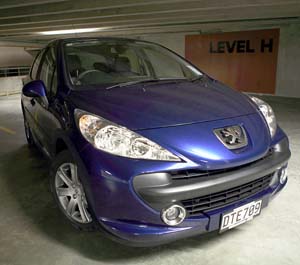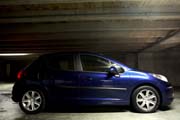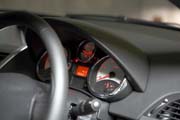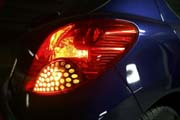|
living: autocade
 A green lesson A green lesson

 It’s a crime for the Peugeot 207 HDI 110 not to be sold in more places, as it’s good for the environment, says Jack Yan It’s a crime for the Peugeot 207 HDI 110 not to be sold in more places, as it’s good for the environment, says Jack Yan
photographed by Douglas Rimington
I CALLED ARMSTRONG
PEUGEOT on the Monday night, wondering
if they had the 207 HDI—the new
small diesel from the French company—ready a day early. The
following day, I was to ferry Miss New Zealand Laural Barrett and
her sister Sharaine about, and I didn’t think putting the girls
into my two-seater would be any fun. Why not have a brand-new car
and be good to the environment at the same time?
God bless Armstrong: they were ready. I would
not be guilty of trying to put one of the Barrett twins into the
non-existent back seat of my regular car.
I am reasonably familiar with Peugeots and estimate
that I have driven or owned 10 of them in my lifetime. And the 207,
which is a fairly common sight in France, deserves to do well in
New Zealand, even when you aren’t ferrying beautiful women
around.
The issue is whether beautiful women think much
of it.
Neither of the Misses Barrett thought ill of
the 207, but then it wasn’t that remarkable as a style proposition,
either. Another female friend said she loved how it drove and handled,
but that when exiting the car, it was a let-down. In other words,
Peugeot’s internal styling team might have to work harder for
the facelift because there is, to the layman’s eyes, a similarity
to the 206.
Assembly quality and the little faux aluminium
touches inside the car really lift the ambience, so Peugeot has
got things right inside. The plastics are slightly better on its
arch-rival, the Renault Clio III, based on Lucire drives
in France, but everything is a step up from the 206.
We even think the styling, critics aside, is
right, combining the low nose that has already been seen on everything
from the 1007 to the 407 Coupé. It exhibits the Peugeot brand
well and contemporizes the look, one which people have been trying
to copy since the cute 205 was launched in 1983.
The HDI, in particular,
is celebrated by its manufacturer as a clean diesel, with a carbon
dioxide rating of 126 g/km, totally acceptable for a turbocharged
B-class car. Before you think that means a wimpy performance, think
again: the 1·6, 108 PS motor
has good, low-end torque (thanks to its turbocharger) and excellent
gearing, as many French cars do, allowing one to pull away from
tricky situations around the Arc de Triomphe. It also trumps the
Clio by a few horsepower.
During the Lucire week-long test, we didn’t
have to fill the tank once, nor did we suffer the embarrassment
of returning it with an eighth of a tank left. The claim of 48 mpg
is not far-fetched and we did reach that ourselves. It makes the
sub-NZ$34,000 price tag acceptable,
though it does push the Peugeot beyond the price of, say, a roomier
Toyota Auris (Corolla Hatchback) in this market. (The base model
price, with a simpler grille and lower levels of equipment, is more
acceptable, closer to that of the Yaris.)
The main disappointment is not so much pricing—this
publication goes to countries in which the 207 HDI
is more competitively priced—but the fact it isn’t sold
in more places.
The 207 has the potential now to be Peugeot’s
world car, in the same vein as the Volkswagen Golf, but pursuing
a far more environmentally friendly angle. For cost reasons, Peugeot
has decided that it’s the 206 that goes everywhere from Red
China (where it’s badged as a Citroën) to Iran (where
it’s locally made by Iran Khodro).
The greatest omission is the United States, from
where Peugeot pulled out many years ago. It has been talking about
returning to North American shores, where an eco-207 could do very
well.
With some models sharing a powerplant with the
Mini Cooper S—itself a hit in the US,
toppling the idea that Americans only buy big cars and SUVs—there’s
little reason (other than launch costs) the 207 wouldn’t make
an impact as a contemporary and clean car.
Californians wanting something more original
than a Mini and less boxy than a Scion might clamour for the French
car’s charms, especially when pushing the clean, green angle.
If Honda can sell its rather older Fit there (Jazz in some export
markets) many years after its original launch, then imagine what
effect the newer 207 would have.
Here in New Zealand, it could do especially well
with similarly minded eco-conscious consumers, even as a country
that abandoned mainstream use of natural gas in cars in 1996. If
we are willing to pay extra for organic food, then why not pay extra
for an environmentally conscious car?
If fielding a full range—that’s the
hatches, the new wagons, including the Matra Rancho-ized 207 Outdoor,
and the coupé–cabriolet—this car could dominate its sector. It’s already the top-selling car in Europe, beating the Volkswagen Golf.
And, when weighing up the effect on the environment,
we are only talking an extra 22 g/km of carbon dioxide relative
to the Toyota Prius, a car which sells for nearly NZ$9,000
more.
Forget the comparisons to mainstream Yarises
and Aurises. Next to the Prius, the 207 is a convincing and far
less complex ecomobile. •
Add
to Del.icio.us | Digg
it | Add
to Facebook
|




Photographed by Douglas
Rimington
An eco-207 could do well in the US: Californians wanting something more original than a Mini and less boxy than a Scion might clamour for the French car’s charms, especially when pushing the clean, green angle
|

